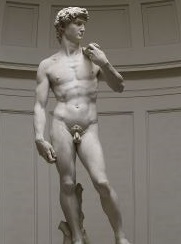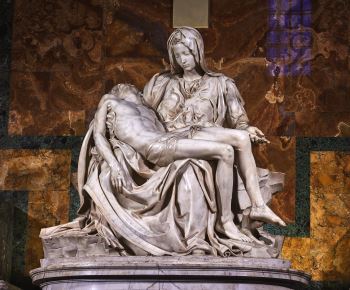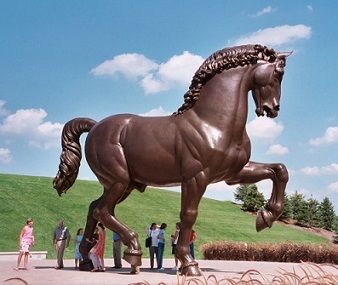What Are the Key Features That High Renaissance Art Have in Common Early Renaissance Art
Beginnings of High Renaissance
The Term Renaissance
It wasn't until 1855 that a French historian named Jules Michelet start coined the word "Renaissance" to refer to the innovative painting, architecture, and sculpture in Italy from 1400-1530. His apply of the term was informed by Renaissance historian Giorgio Vasari's mention of "rebirth" to draw the same period in his The Lives of the Most Excellent Painters, Sculptors, and Architects (also known as Lives of the Artists) (1568).
The term was informed by eighteenth century archeologist and art historian Johann Joachim Winckelmann's The History of Ancient Art in Artifact (also translated equally The History of Ancient Art) (1764) characterizing the Classical art of the Greeks as the "High Style." Winckelmann's basis-breaking book launched the study of art history and became foundational to European intellectual life, as well as reaching a popular audience. He felt that the purpose of fine art was beauty, an ideal obtained by the Greeks and in High Renaissance art, as he wrote, "the Italians alone known how to pigment and figure beauty."
Past the early 1800's the term Hochenrenaissance, High german for High Renaissance, was used to refer to the period, defined as kickoff around the fourth dimension of Leonardo da Vinci'south The Terminal Supper (1490's) and ending with the Sack of Rome past the army of Emperor Charles V in 1527. In the terminal thirty years, some contemporary scholars have criticized the term as being an oversimplification.
The Transition from the Early Renaissance

High Renaissance artists were influenced past the linear perspective, shading, and naturalistic figurative treatment launched by Early Renaissance artists like Masaccio and Mantegna. Simply they mastered those techniques in order to convey a new aesthetic ideal that primarily valued beauty. The homo figure was seen as embodying the divine, and new techniques similar oil painting were employed to convey human movement and psychological depth in gradations of tone and color. Drawing upon the classical Greek and Roman proportional preciseness in architecture and anatomical correctness in the torso, masters similar Leonardo, Michelangelo, and Raphael created powerful compositions where the parts of their subjects were illustrated as harmonious and cohesive with the whole.
Leonardo da Vinci

The High Renaissance began with the works of Leonardo da Vinci as his paintings, The Virgin of the Rocks (1483-1485), and, almost notably, The Last Supper (1490s), exemplified psychological complexity, the use of perspective for dramatic focus, symbolism, and scientifically authentic particular. However, both works were created in Milan, and it wasn't until 1500 when Leonardo moved back to Florence, the thriving center of fine art and civilisation, that his work impacted the city. His study for The Virgin and Child with St. Anne (c. 1499-1500) was displayed at Santissimi Annunziata church where many artists went to written report it.

Leonardo's scientific understanding and observation of natural phenomena and his sense of mathematical proportion were also profoundly influential. His seminal ink drawing Vitruvian Man (1490) showed ideal man proportions correlating with platonic architectural proportions avant-garde past the Roman architect Vitruvius in his De architectura (30-15 BCE). The cartoon is occupied by Leonardo's writing that illustrates his deep scientific inquiries into beefcake as, for example, "the length of the outspread arms is equal to the summit of a human."
Leonardo was not but a noted painter, but as well a polymath who has been chosen the father of architecture, ichnology, and paleontology, amidst other fields. He was a noted inventor, cartographer, engineer, and his findings and observations, recorded in his notebooks, found their manner into various collections, chosen the Codex Arundel (1480-1518) and Codex Leicester (1510), among others. To some, these notebooks have become equally valued equally his artworks.
An Age of Masters and Rivalries

The High Renaissance was dominated by a few historic masters and the competitive rivalries that developed between them as they vied, not only for noble patronage, only also for supreme excellence in their art. In Florence, at the aforementioned fourth dimension that crowds gathered to view Leonardo's cartoon for The Virgin and St. Anne (c. 1499-1500), Michelangelo had become a ascension star with his creation of the Pietà (1496-1498).
Michelangelo viewed sculpture as the pre-eminent art and, even in painting, sculpted the human grade. With the creation of the iconic statue David (1501-1504), his reputation as the sculptor whose works exemplified the High Renaissance was established. David was given a central place in the city of Florence, upholding the city-state's spirit of defending its civil liberties.

A rivalry adult between Michelangelo and Leonardo, beginning in 1504 with their competing frescoes commissioned for opposing walls in the Hall of Five Hundred. Equally art critic Jonathan Jones wrote of Michelangelo, "He was fiercely competitive and needed to outdo Leonardo. Information technology became a contest not of skill, in which they were both beyond compare, merely imagination and originality. Leonardo, the older artist, was already famous non merely as a gifted painter simply a truly original mind... [Michelangelo] set out his claim to a similar kind of personal, unique vision." That personal vision can be seen in the artist'due south pick of a battle scene where nude bathers were attacked, thus assuasive for a dynamic, and substantially sculptural, treatment of the male nude.
The two frescos, Leonardo's The Battle of Anghiari (1503-1506), and Michelangelo'due south Battle of Cascina (1504-1506), were unfortunately not completed, as both men were pulled toward other commissions. All the same the works connected to influence other artists, notably Raphael, who would continue to copy the masterpieces in efforts to further their own artistic practices.
Pope Julius II
Rome became the artistic center of the Loftier Renaissance due to the patronage of Pope Julius II, who reigned from 1503-1513. Julius II was a noted fine art collector, owning the Laocoon (c. 42-20 BCE) and the Apollo Belvedere (c. 120-140), along with other noted classical works, which became the foundation for the Vatican'southward art museums. He was a formidable personality who made the Papacy into an economical and military strength that dominated much of Italy. His goal was to brand Rome the cultural center of Europe instead of Florence. To achieve this, he ardently pursued the neat artists of the day, persuading Raphael to movement to Rome to paint the frescoes of the Vatican's papal apartments. Later commissioning Michelangelo to create the papal tomb. he cajoled the reluctant sculptor into painting the Sistine Chapel ceiling (1508-1512). The Pope'south ambition to rebuild St. Peter's Basilica and redesign the Vatican led him to recruit Bramante, Michelangelo, and Raphael into roles every bit architects of his g plans. After Julius II's death, papal patronage of the arts connected under Pope Leo X, the son of Lorenzo de' Medici, patriarch of the ruling (and art loving) family of Florence.
High Renaissance: Concepts, Styles, and Trends
Renaissance Man

During the Early on Renaissance years, the concepts of Humanism were widely promoted. Whereas the previous Gothic menses'south art had emphasized the idolization of the secular and the religious, artists in fourteenthursday century Florence were more concerned with man's place in the world. Loftier Renaissance artists evolved this inquiry by exploring the concept of "universal human," in other words, an individual of genius, divinely inspired, who could excel in all aspects of art and science. The term "Renaissance homo" is notwithstanding used today to describe a well-rounded and multi-talented person who exhibits mastery in a wide array of intellectual and cultural pursuits.
This ideal, developed from Leon Battista Alberti's "A man can do all things if he will," was exemplified in Leonardo da Vinci, as Vasari in his Lives of the Artists (1568) wrote, "In the normal course of events many men and women are born with remarkable talents; but occasionally, in a way that transcends nature, a single person is marvelously endowed past Heaven with beauty, grace and talent in such affluence that he leaves other men far backside, all his actions seem inspired and indeed everything he does clearly comes from God rather than from human skill. Everyone acknowledged that this was truthful of Leonardo da Vinci, an creative person of outstanding physical beauty, who displayed infinite grace in everything that he did and who cultivated his genius so brilliantly that all problems he studied he solved with ease."
This standard non merely dominated the menstruation but subsequent thinking on creative ability, positioning the artist as a divinely inspired genius, rather than just a noted craftsman.
Innovations in Painting
While High Renaissance painting continued the tradition of fresco painting in connection with religious scenes, the practise of masters like Raphael, Leonardo, and Michelangelo was informed by innovations of the medium. For example, to paint the Sistine Chapel, Michelangelo non only designed a scaffolding organization to reach the area but developed a new formula and application for fresco to counter the problem of mold, every bit well as a wash technique and the use of a variety of brushes, to first apply color then, later on, add fine item, shading, and line. For his Last Supper (1490s), Leonardo experimented by working on dry fresco and used a combination of oil and tempera to achieve an oil painting result. Raphael, Leonardo, and Michelangelo all employed trompe l'oeil in their frescoes, a technique by which to attain the illusion of a pictorial space that integrates into its surrounding architectural environment.
At the same time, many masterworks of the Loftier Renaissance were, for the showtime fourth dimension, being painted in oil, typically on wood panels but sometimes on canvas. Because oils provided more than possibilities in subtle tonal and color gradations, the resulting works were more than life-like. As a issue, a new trunk of compelling portraiture of ordinary people emerged. Leonardo's Mona Lisa is undoubtedly the most famous example. Other High Renaissance artists like Andrea del Sarto in his Madonna of the Harpies (1517) and Fra Bartolomeo in his Portrait of Girolamo Savonarola (c. 1497-1498) also created powerful works in oil.

Leonardo's practice of oil painting led him to develop a new technique called Sfumato, meaning "vanished gradually like smoke." It involved using translucent glazes worked by castor to create gradual transitions between tones of light and shadow. The result was, every bit Leonardo wrote, "without lines or borders, in the thing of smoke," creating a vivid imitation of reality lacking all evidence of the artist's brushstrokes. Other High Renaissance artists like Raphael, Fra Bartolomeo, and Correggio also mastered the style, which afterward greatly influenced Renaissance painters of The Venetian School like Giorgione, and later, the Mannerist painters.
Quadratura
Quadratura was the term used for the burgeoning ceiling paintings genre of the time, remarkable for the way they unified with the surrounding architecture, and known for their employment of trompe 50'oeil. These works not only included the seamless integration between painting and location, but also oftentimes required the creation of fictive architectural features to visually reconfigure the site. The use of quadratura was used often in Catholic churches to produce an awe-inspiring event, which was in straight opposition to the motion toward Protestantism that would after go the Reformation.

Quadratura required visual-spatial skill and a masterful employment of linear perspective that had beginning been pioneered by Andrea Mantegna in his Camera degli Sposi (1465-1474) ceiling in the Ducal Palace of Mantua. His work notably influenced Antonio Allegri da Correggio, known simply equally Correggio, the leader of the High Renaissance in Parma.
Correggio'due south ceiling frescos, Vision of St. John the Evangelist on Patmos (1520-1521) and Assumption of the Virgin (1524-30), further developed the illusionary effects of quadratura through his use of new revolutionary techniques like the foreshortening of bodies and objects and then that they appeared authentic when seen from below. This method, likewise known every bit prospettiva melozziana, or "Melozzo's perspective," was developed by Melozzo da Forlì, an Italian artist and builder.
Compages

The leading builder of the Loftier Renaissance was Donato Bramante, almost noted for his accent on classical harmony, employment of a fundamental programme, and rotational symmetry, as seen in his Tempietto (1502). Rotational symmetry involved the use of octagons, circles, or squares, so that a building retained the same shape from multiple points of view. He likewise created the outset trompe l'oeil effect for architectural purposes at the church of Santa Maria presso San Satiro in Milan. Due to the presence of a road backside the wall of the church, only three feet remained for the choir area, so the architect used linear perspective and painting to create an illusionary sense of expanded space.

Bramante's educatee Antonio da Sangallo the Younger designed the Palazzo Farnese which was called by Sir Barister Fletcher, "The about imposing Italian palace of the 16thursday century." The design adhered to classical principles, had a Spartan simplicity, and used rustication, which left the building rock in its textured and unfinished state assuasive for natural lines and color. The era, notwithstanding, was marked past competing designs and personal rivalries. Fundamental Farnese who became Pope Paul III in 1534 was dissatisfied with the cornice blueprint of the Palazzo and held a contest for a new design, which was awarded to Michelangelo. The popular story recounts how Sangallo the Younger died of shame the following yr, as Michelangelo completed the building'south final touches.
Michelangelo was Bramante's primary rival, as, in later life, he worked as an architect. He designed the Laurentian Library in Florence and created the dome for St. Peter'south Basilica, though the building as a whole reflected the work of Bramante, Raphael, and afterward architects like Bernini. This work, which took place between 1523-1571, was particularly innovative; creating a dynamic sense of movement in the staircase and wall features that was influential upon later architects.
Sculpture

The undoubted master of sculpture during the High Renaissance was Michelangelo whose Pietà, (1498-1499), finished when he was simply twenty-four, launched his career. He chose to depict an unusually youthful Virgin Mary holding the dead Christ in her lap. Although the handling of this scene was popular in France, it was entirely new to Italian art. The work's pyramidal composition and naturalistic figurative treatment created a powerfully classical consequence. Yet, the work also showed innovative variations. The monumental scale of the Virgin in comparing to Christ lent a highly emotional maternal aspect to the slice and became a signature method for the creative person in his work, this manipulation of high dissimilarity. Unlike Early Renaissance sculptors like Donatello who worked in bronze, Michelangelo single handedly revived the classical utilize of marble, and injected elements of monumentality into all of his subsequent sculptures, both in the size of the figures, and the scale of the projects.

Leonardo also explored sculpture, notably designing the globe's largest bronze equestrian statue. Commissioned by the Duke of Milan in 1482 to honor his father, the projection was never completed, as the artist's 24-foot tall clay model was destroyed by the French ground forces invasion of Milan in 1499. Several versions of the horse, based upon the artist's drawings, have been completed in mod times.
Later Developments - After High Renaissance
The ethics and humanism that informed the High Renaissance continued to inspire the world across Italy, albeit with notable stylistic and artistic variation. Its influence would reach into the North European Renaissance, exemplified by Albrecht Dürer, Pieter Bruegel, and others, and the Venetian Renaissance and the Venetian School of Painting, led by Giorgione and Titian and the architect Palladio. Meanwhile, Correggio's quadratura works influenced the artists Carlo Cignani, Gaurdenzio Ferrari, Il Pordenone, and had a notable touch on on Baroque and Rococo treatments of domes and ceilings.
Leonardo's death in 1519, followed by Raphael's death when he was only 37 years quondam the following year, marked a lessened vibrancy of the Italian High Renaissance. The sack of Rome by the armies of Holy Roman Emperor Charles V in 1527 ended the era. The brutal and terrifying event reduced the population of Rome from 55,000 to 10,000, and left the city in a land of collapse and financial ruin. The ideals of the High Renaissance no longer seemed tenable to many. Michelangelo'south Last Judgment (1536-41) a fresco in the Sistine Chapel expressed the darker emotional tenor of the following decades. In sculpture he turned to pietas and depictions of captive slaves such as his The Atlas Slave (1530-34).
Michelangelo later approaches in expression influenced the Mannerists, including Jacopo da Pontormo, Rosso Fiorentino, Giorgio Vasari, and Francesco Salviati. His figurative treatment, especially of the male person nude, influenced countless artists. Later artists of the Baroque menses, the Neoclassicists, and the avant-garde movements of the 20th century were also widely influenced by the works of the Renaissance. For example, Pablo Picasso drew upon Raphael in his Guernica (1937), referencing The Fire in the Borgo (1514), which depicted a adult female handing her babe to those below as she leaned out of the called-for edifice.
The works created by the artists of the Italian High Renaissance remain the most recognizable and popular works of art history. The Mona Lisa, The Last Supper, The Creation of Adam, and The Sistine Madonna, have been reproduced on countless consumer items, referenced in popular songs, Goggle box shows, videos, and ofttimes used in advertising.
Furthermore, the ideas of the High Renaissance - the artist as genius, the foundational nature of classical fine art, the individual every bit middle of the universe, the value of science and exploration, the emphasis on Humanism - accept all deeply informed the social and cultural values of the world ever since.
neighbourmanthaten.blogspot.com
Source: https://www.theartstory.org/movement/high-renaissance/history-and-concepts/#:~:text=The%20High%20Renaissance%20began%20with,symbolism%2C%20and%20scientifically%20accurate%20detail.